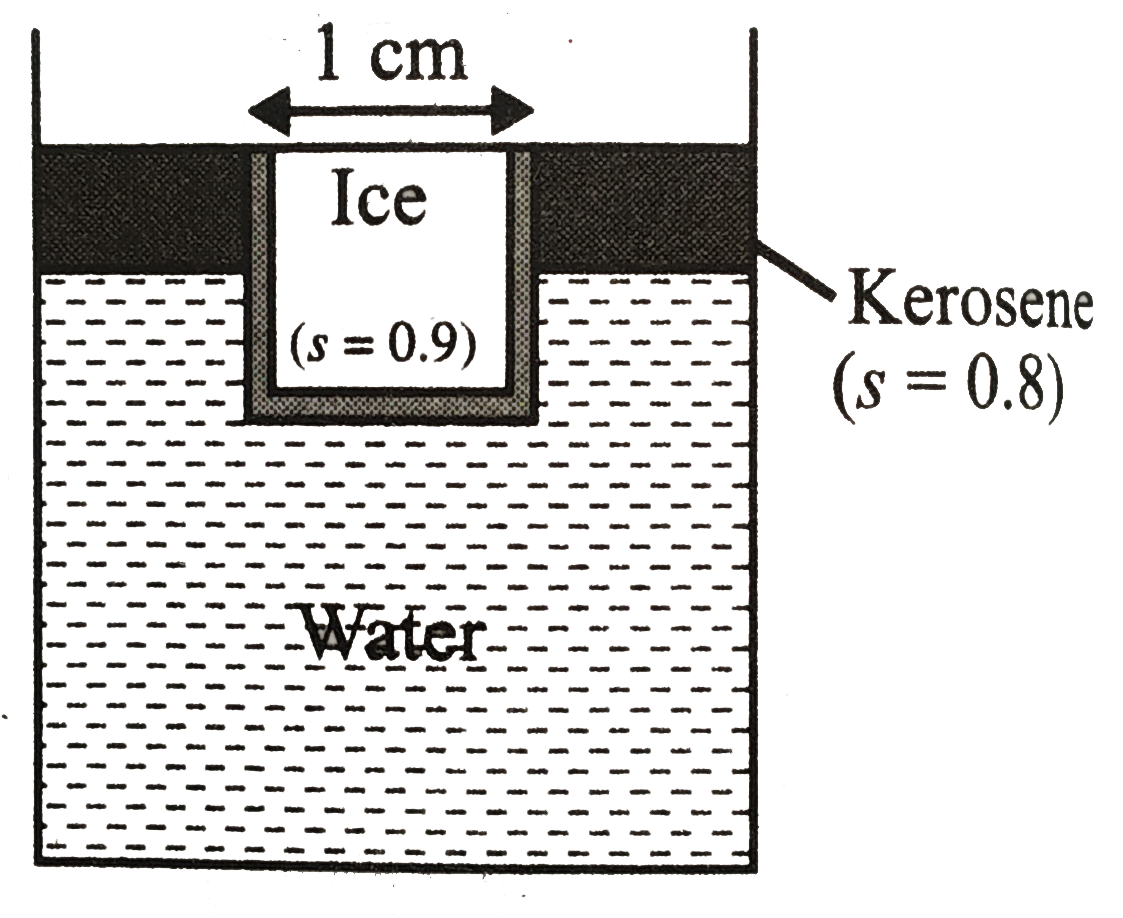An ice cube of edge a is placed in an empty cylindrical vessel of radius 2a. Find the edge (in cm) of ice cube when it just leaves the contact with the bottom assuming that ice melts uniformly maintaining its cubical shape. Take a = 12 π cm (Ice is lighter than water)Solution in Tamil
The correct Answer is:B, C
Let xrarr edge of ice block.
when it just leaves contact with the bottom of the glass,
hrarr Height of water method from ice.
here W=U
→(x)3×ρice×g=(x)2×h×ρw×g
→h=(0.9)x
Again volume of water formed from melting of ice is given by
(4)3−(x)3=π×(r)2×h−xI2h
[because amont of water =ρ(r2−x2)h→(4)3−(x)3=π×(3)2×h−x2h]
utting h=0.9x
rarr (4)^3-(x)^3pixx(3)^2xx(0.9)x<br>solv∈gtheaboveequationwecan≥t<br>x=2.26cm
Topper's Solved these Questions
Similar Questions
Find the accelerationof the moon with respect to the eath from the following data, Distance between the earth and the moon =3.85×105 km and the time taken by the moon to complete one revolution around the earth =27.3days
02:02View SolutionA body slipping on a rough horizontal plane moves wioth a deceleationof 4.0ms. What is cofficient of kineic friction between the block and the plane?
04:05View SolutionA piece of ice is in the form of a cube melts so that the percentage error in the edge of cube is a , then find the percentage error in its volume.
07:56View SolutionConsider an ice cube of edge 1.0 cm kept in a gravity-free hall. Find the surface area of the water when the ice melts. Neglect the difference in densities of ice and water.
01:46View SolutionAn ice cube of side 1 cm is floating at the interface of kerosene and water in a beaker of base area 10 cm^(2) . The level of kerosene is just covering the top surface of the ice cube. a. Find the depth of submergence in the kerosene and that in the water. b. Find the change in the total level of the liquid when the whole ice melts into water.
01:56View SolutionA piece of ice floats in a liquid denser than water. The liquid fills the vessel upto the edge. If ice melts completely then
07:12View SolutionStatement-1: An ice cube is floating in water in a vessel at 0∘C when ice cube melts level of water in the vessel remain same.
Statement-2: Volume of melted ice is same as volume of water displaced by ice.01:59View Solution6 cm आंतरिक व्यास के एक बेलनाकार गिलास में 4 cm किनारे वाला बर्फ का एक घनाकार टुकड़ा रखा है | मान ले कि बर्फ सभी सतहों पर समान रूप से पिघलती है जिससे उसकी आकृति सदा घनाकार बनी रहती है | इस घन के किनारे की लंबाई बताएँ जब गिलास की पेंदी द्वारा इसपर लगनेवाला संपर्क बल शून्य हो जाए |
04:02View SolutionAn ice cube floats on the surface of a flass of water (density of ice = 0.9 g//cm^(3)). When the ice melts will the water level in the glass rise ?
03:08View SolutionAn ice-cube of edge is 10 cm floating in water. Time period of small vertical oscillations of the cube is: (Specific gravity of ice is 0.9)
07:03View SolutionWhen an ice cube melts and becomes water , the ice water system undergoes
02:07View SolutionA cube of ice of edge 4 cm is placed in an empty cylindrical glass of inner diameter 6 cm. Assume that the ice melts uniformly from each side so that it always retains its cubical shape. Remembering that ice is lighter than water, find the length (in cm) of the edge of the ice at the instant it just leaves the contact with the bottom of the glass.
03:32View SolutionA piece of ice is in the form of a cube melts so that the percentage error in the edge of cube is a , then find the percentage error in its volume.
04:24View SolutionConsider an ice cube of edge 1.0 cm kept in a gravity-free hall. Find the surface area of the water when the ice melts. Neglect the difference in densities of ice and water.
02:29View SolutionAn ice cube of side 1cm is floating at the interface of kerosene and water in a beaker of base area 10cm2. The level of kerosene is just covering the top surface of the ice cube.
a. Find the depth of submergence in the kerosene and that in the water.
b. Find the change in the total level of the liquid when the whole ice melts into water.
 03:35View Solution
03:35View SolutionAn ice-cube of edge is 10 cm floating in water. Time period of small vertical oscillations of the cube is: (Specific gravity of ice is 0.9)
03:13View Solution

